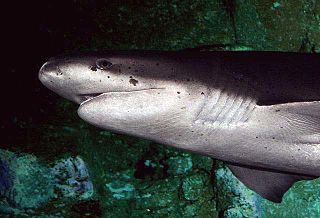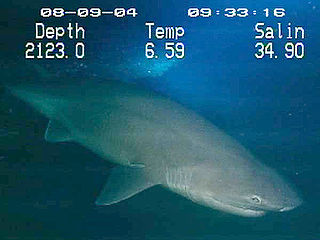
The Hexanchiformes are a primitive order of sharks, numbering just seven extant species in two families. Fossil sharks that were apparently very similar to modern sevengill species are known from Jurassic specimens.

Cow sharks are a shark family, the Hexanchidae, characterized by an additional pair or pairs of gill slits. Its 37 species are placed within the 10 genera: Gladioserratus, Heptranchias, Hexanchus, Notidanodon, Notorynchus, Pachyhexanchus, Paraheptranchias, Pseudonotidanus, Welcommia, and Weltonia.

The Lamnidae are the family of mackerel sharks known as white sharks. They are large, fast-swimming predatory fish found in oceans worldwide, though prefer environments with colder water. The name of the family is formed from the Greek word lamna, which means "fish of prey", and was derived from the Greek legendary creature, the Lamia.

Hybodus is an extinct genus of hybodont that lived from the Middle Triassic to the Late Cretaceous periods. Species closely related to the type species Hybodus reticulatus lived during the Early Jurassic epoch. Numerous species have been assigned to Hybodus spanning a large period of time, and it is currently considered a wastebasket taxon that is 'broadly polyphyletic' and requires reexamination.
Dale Alan Russell was an American-Canadian geologist and palaeontologist. Throughout his career Russell worked as the Curator of Fossil Vertebrates at the Canadian Museum of Nature, Research Professor at the Department of Marine Earth and Atmospheric Sciences (MEAS) at North Carolina State University, and Senior Paleontologist at the North Carolina Museum of Natural Sciences. Dinosaurs he has described include Daspletosaurus and Dromiceiomimus, and he was amongst the first paleontologists to consider an extraterrestrial cause for the Cretaceous–Paleogene extinction event. Russell also helped lead the China-Canada Dinosaur Project from 1986 to 1991.

Ichthyornithes is an extinct group of toothed avialan dinosaurs very closely related to the common ancestor of all modern birds. They are known from fossil remains found throughout the late Cretaceous period of North America, though only two genera, Ichthyornis and Janavis, are represented by complete enough fossils to have been named. Ichthyornitheans became extinct at the Cretaceous–Paleogene boundary, along with enantiornitheans, all other non-avian dinosaurs, and many other animal and plant groups.
Pasquiaornis is a prehistoric flightless bird genus from the Late Cretaceous. It lived during the late Cenomanian, between 95 and 93 million years ago in North America.
Canadaga is a flightless bird genus from the Late Cretaceous. The single known species is Canadaga arctica. It lived in the shallow seas around what today is Bylot and Devon Islands in Nunavut, Canada. Its fossils were found in rocks dated to the Campanian to mid-Maastrichtian age, about 67 million years ago.

Ischyrhiza is an extinct genus of sclerorhynchoid ray from the Late Cretaceous (Cenomanian-Maastrichtian).

Terminonaris is a genus of extinct pholidosaurid crocodyliforms that lived during the Late Cretaceous epoch. The name means: “enlarged snout or nose” at the front of the skull. Terminonaris is an early crocodile, within a subgroup called Mesoeucrocodylia. Its remains have only been found in North America and Europe. Originally known under the generic name Teleorhinus, it was once believed to be a teleosaurid. Both prehistoric crocodiles such as Terminonaris, as well as modern crocodiles, belong to the same group called crocodyliformes, although modern crocodiles have specific features that indicate they are distant relatives of this species and members of the subgroup Eusuchia.

The Dunvegan Formation is a stratigraphical unit of Cenomanian age in the Western Canadian Sedimentary Basin.
Gladioserratus is an extinct genus of cow shark. It contains three species:

Dwardius is an extinct genus of cardabiodontid sharks which existed during the Cretaceous period in what is now Australia, England, France, and India. It was described by Mikael Siverson in 1999, as a new genus for the species Cretalamna woodwardi, which had been described by J. Hermann in 1977. Another species, D. siversoni, was described from the middle Albian of northeastern France by V.I. Zhelezko in 2000; the species epithet honours the author of the genus. A new species, D. sudindicus, was described by Charlie J. Underwood, Anjali Goswami, G.V.R. Prasad, Omkar Verma, and John J. Flynn in 2011, from the Cretaceous Karai Formation of India.
Cretorectolobus is an extinct carpet shark. It was described by G.R. Case in 1978, and the type species is C. olsoni, which existed during the Campanian in Canada and the United States. Another species, C. gracilis, was described by Charlie J. Underwood and Mitchell in 1999, from the Hauterivian to Barremian strata of the Speeton Clay Formation of England. The species epithet refers to the shark's teeth, which Underwood and Mitchell described as gracile and narrow in form. A new species, C. robustus, was described from the Cenomanian of Canada by Underwood and Stephen L. Cumbaa in 2010.

Meristodonoides is an extinct genus of hybodont. The type species is M. rajkovichi, which was originally a species in the genus Hybodus. The species, along with other Hybodus species such as H. butleri and H. montanensis, was reassigned to Meristodonoides by Charlie J. Underwood and Stephen L. Cumbaa in 2010. The species is primarily known from remains from the Cretaceous of North America, spanning from the Aptian/Albian to Maastrichtian, making it one of the last surviving hybodont genera, though records of the genus likely extend back as far as the Late Jurassic, based on an undescribed skeleton from the Tithonian of England, and fragmentary teeth from the Kimmeridgian of Poland, England and Switzerland. Other remains of the genus are known from the Coniacian of England, the Aptian-Albian of France, and the Campanian of European Russia. The morphology of the teeth suggests an adaptation to tearing prey. Fossils from the Western Interior Seaway suggest that it preferred nearshore marine environments, being absent from deeper-water areas, with it likely also being able to tolerate brackish and freshwater conditions.
Orectoloboides is an extinct genus of wobbegong sharks. It was described by Cappetta in 1977. A new species, O. angulatus, was described from the Cenomanian age of Canada by Charlie J. Underwood and Stephen L. Cumbaa in 2010.
Roulletia is an extinct genus of sand sharks. It was described by Romain Vullo, Henri Cappetta, and Didier Néraudeau in 2007, and the type species is R. bureaui, which existed during the upper Cenomanian of what is now France. The genus was named after its type locality, Roullet-Saint-Estèphe, while the species epithet honours Michel Bureau, an amateur paleontologist who gathered the material for the species. Another species, R. canadensis, was described from the Cenomanian of Canada by Charlie J. Underwood and Stephen L. Cumbaa in 2010. The species epithet refers to the country in which it was discovered. It has been suggested tentatively this genus may be related to Haimirichia, which has been placed in its own family (Haimirichiidae) based on soft-tissue preservation.
The Favel Formation is a stratigraphic unit of Late Cretaceous age. It is present in southern Manitoba and southeastern Saskatchewan, and consists primarily of calcareous shale. It was named for the Favel River near Minitonas, Manitoba, by R.T.D. Wickenden in 1945.

Herasmius is an extinct genus of heterosteid placoderm from the Devonian period. Fossils have been discovered freshwater deposits in Norway and Canada.










